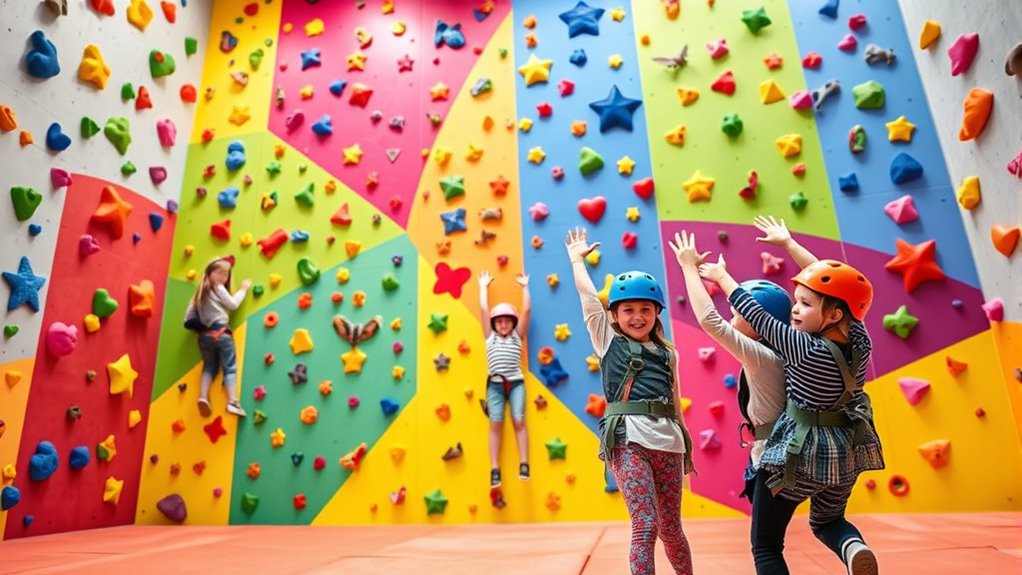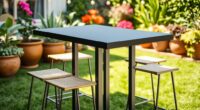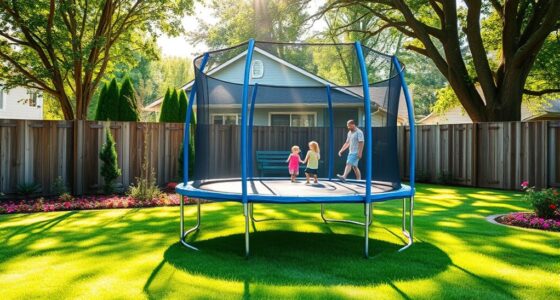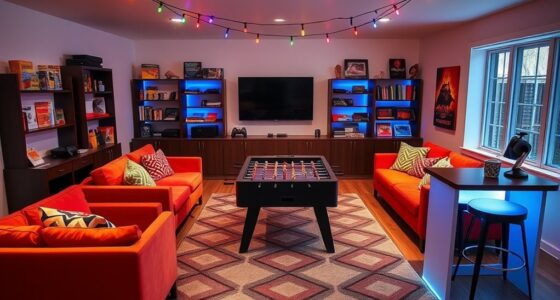To build an indoor climbing wall for kids, start with sturdy 3/4-inch plywood securely attached to spaced wall studs, and sand everything smooth. Use colorful, durable climbing holds, and make certain you install proper T-nuts and bolts for stability. Add thick crash mats underneath for safety, and consider themed decorations or adjustable angles for fun. Using safety gear like helmets and proper padding makes all the difference. If you want to learn more about customizing and safety tips, keep exploring further.
Key Takeaways
- Use sturdy 3/4-inch plywood attached securely to wall studs, pre-drilling holes for T-nuts and mounting climbing holds safely.
- Reinforce wall structure and install safety padding or crash mats beneath the climbing surface to prevent injuries.
- Select durable, kid-friendly holds with positive edges, and arrange them low and close together for easy gripping and progression.
- Incorporate themed decor or murals, and consider modular sections or additional features like monkey bars for variety and engagement.
- Regularly inspect safety gear, padding, and the climbing surface to ensure ongoing safety and maintenance.
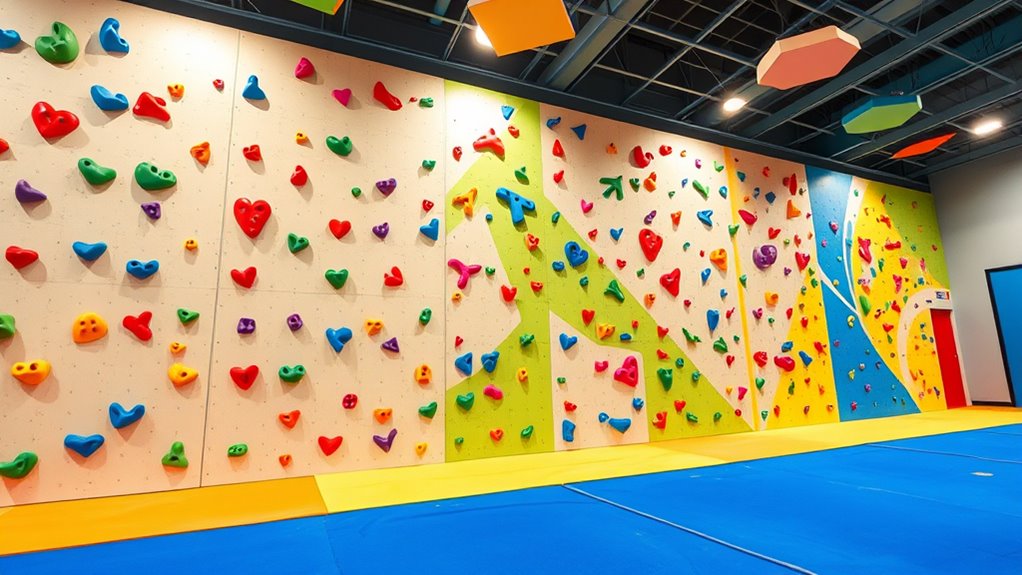
Building a climbing wall for kids indoors is a fun and practical way to promote physical activity and develop climbing skills in a safe environment. To guarantee safety and durability, start with sturdy materials like 3/4-inch plywood for the wall surface. Verify that your wall studs are spaced 16 inches apart or less; if not, reinforce the structure to prevent wobbling or collapse. Sand all wood surfaces thoroughly to eliminate splinters and apply wood filler where needed, creating a smooth, safe climbing area. Proper construction techniques are essential to ensure the wall remains stable and safe for children to use over time. Safety gear plays an essential role in protecting young climbers. Recommending helmets and climbing shoes helps prevent injuries and encourages proper climbing habits. Place crash mats or thick padding beneath the wall, increasing their thickness as the height of the climbing surface grows. This cushioning absorbs falls and minimizes injury risk, especially for beginners or younger children. Gather essential materials like plywood sheets, climbing holds, T-nuts, bolts, and 2×4 studs. You’ll need basic tools such as a cordless drill, hammer, Allen wrench, saw, and sandpaper to assemble the wall. For better grip and aesthetics, consider applying textured paint or water-based urethane on the surface. Some families choose to make their own wood holds for cost savings and customization, but make sure to smooth out sharp edges to prevent cuts. Building a basic indoor climbing wall can be quick and affordable, typically costing around $120 and taking about an hour to complete. Larger or more intricate designs with premium holds or custom features will cost more, but buying in bulk reduces per-hold expenses and offers more route options. DIY wood holds might lower costs but require extra time for cutting and smoothing. When selecting holds, prefer gym-style resin options like polyester or polyurethane for durability and grip. Avoid cheap plastic holds, which are slick and hinder skill development. Choose small to medium-sized holds with positive edges suited for children’s hands. Place holds low and close together initially, allowing kids to easily grasp and climb while offering opportunities to progress to higher sections as their skills improve. Modular systems make it simple to change routes and add variety over time. During construction, measure and cut plywood to your desired dimensions, then attach it securely to wall studs with appropriate screws, countersinking them to create a smooth surface. Pre-drill holes for the T-nuts and install them on the back of the plywood before attaching holds with bolts and an Allen wrench. Finish by sanding, filling gaps, and optionally painting or coating with textured finish. Incorporating smart home technology can enhance safety features such as automated lighting or security monitoring, providing extra peace of mind for parents. Design your climbing wall to fit your space, whether it’s a small room or larger play area. Vertical or slightly angled walls are most common. You can add murals or themed decorations to make the area more inviting. Modular sections or additional features like monkey bars increase versatility and keep children engaged. An indoor climbing wall encourages physical fitness, coordination, and problem-solving, providing a safe environment for year-round fun and skill-building for your kids.
Frequently Asked Questions
How Much Space Is Needed to Build an Indoor Climbing Wall?
You need enough space to guarantee safe climbing and landing. Aim for at least 7 feet of clearance around the wall to prevent injuries. Measure your available area, whether it’s a wall or corner, and consider the wall’s height and width. Use flexible padding or flip-up mats to maximize space when not climbing. Prioritize safety zones, wall type, and ease of access for a secure, fun climbing experience.
What Safety Gear Should Kids Wear While Climbing?
When climbing, you should guarantee kids wear essential safety gear. They need a properly fitting harness and helmet to protect their heads and secure support. Climbing shoes with good grip prevent slips, and crash pads cushion falls. Optional items like chalk bags can help with grip. Always supervise, do safety checks, and use reliable belay devices to keep kids safe and confident during their climbs.
Can I Customize the Climbing Wall Design Easily?
Did you know that 78% of indoor climbing gyms offer customizable wall features? You can easily personalize your climbing wall by choosing materials, colors, and shapes that suit your style and space. Modular panels make it simple to update routes and designs without rebuilding. Just guarantee safety, and you’ll create a unique, engaging climbing environment tailored to your preferences, whether for fun, training, or visual appeal.
What Is the Recommended Age Range for Indoor Climbing?
You’re wondering about the ideal age range for indoor climbing. Typically, kids can start as young as 2 with close supervision, but most gyms recommend children begin climbing around age 4 or 5 when they develop enough motor skills and understanding of safety rules. As they grow, they can handle more challenging walls and equipment, with safety increasing from age 10 onward. Always check your local gym’s policies for specific guidelines.
How Often Should the Climbing Wall Be Inspected for Safety?
You should inspect your climbing wall regularly to guarantee safety. Daily visual checks at opening and closing help catch quick issues. Conduct weekly detailed inspections of high-use areas, and perform monthly thorough reviews of all components. For added safety, schedule professional inspections every 2 to 3 years, especially after major events. These inspections verify structural integrity, compliance, and help prevent accidents, giving you peace of mind and maintaining safety standards.
Conclusion
Now that you’ve built your brilliant, bouncy, and beautiful indoor climbing wall, your kids can conquer challenges and cultivate confidence. With creativity, care, and a touch of courage, you’ve created a safe space for their soaring spirits and spirited successes. Every climb, every crawl, encourages exploration and excitement. So, step back, smile, and watch their wonder grow as they bravely bounce, balance, and blast beyond boundaries — building strength and self-esteem one ascent at a time.
